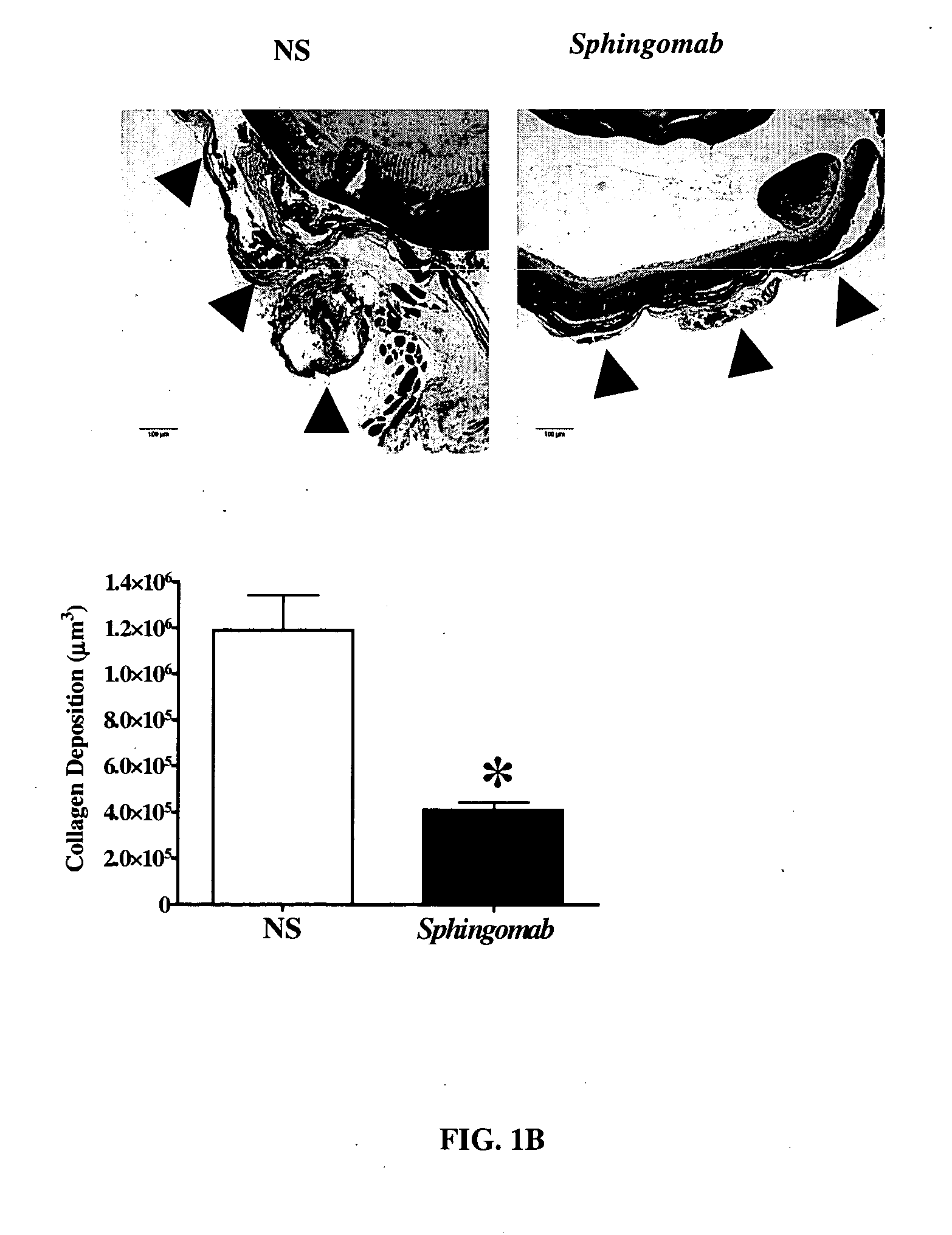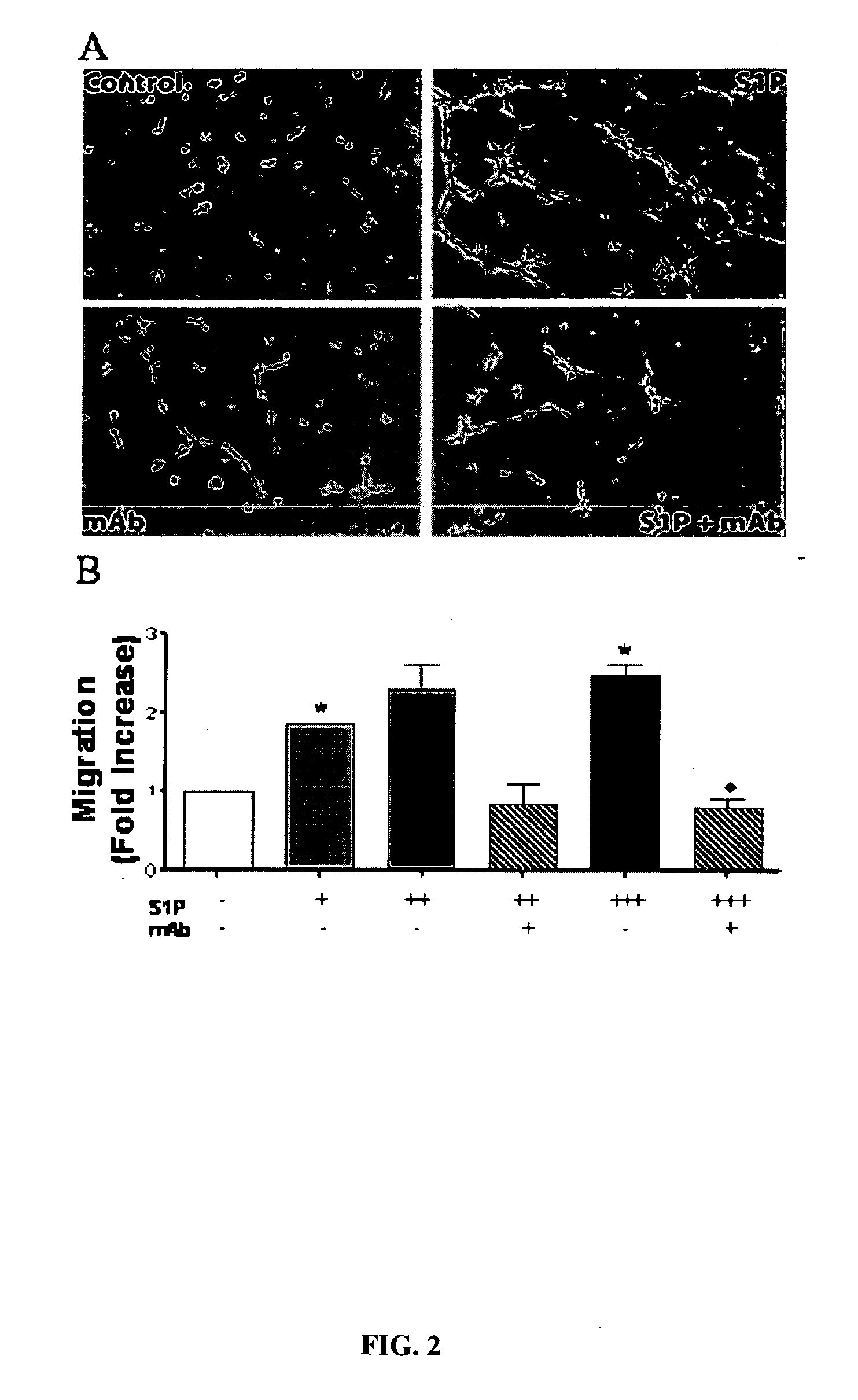Compositions and methods for the treatment and prevention of fibrotic, inflammatory and neovascularization conditions
a fibrotic, inflammatory and neovascularization technology, applied in the field of ocular disorders, can solve the problems of insufficient treatment options, complex search for effective treatments, and unclear amd exact etiology and pathogenesis, so as to reduce or prevent aberrant fibrogenesis, fibrosis or scarring, and modulate surgical and traumatic wound healing responses of the eye.
- Summary
- Abstract
- Description
- Claims
- Application Information
AI Technical Summary
Benefits of technology
Problems solved by technology
Method used
Image
Examples
example 1
SPHINGOMAB Significantly Reduced CNV and Scar Formation in a Murine Model of CNV
[0136] Female C57BL6 / J mice were subjected to laser-induced rupture of Bruch's membrane and administered either 0.5 μg of Sphingomab or an isotype-matched non-specific (NS) antibody diluted in 2 μl of physiological saline. Mice were sacrificed 14 and 28 days after laser rupture.
[0137] To induce CNV lesions, the pupils were dilated with ophthalmic tropicamide (0.5%) and phenylephrine (2.5%). A coverslip was placed on the eye. An Oculight GL 532 nm (Iridex Corporation, Mountain View, Calif.) coupled to a slit lamp set to deliver a 100 msec pulse at 150 mW with a 50 μm spot size was used to rupture Bruch's membrane in three quadrants of the right eye located approximately 50 μm from the optic disc at relative 9, 12 and 3 o'clock positions. The left eye served as an uninjured control in all cases. Any lesion not associated with a vapor bubble or lesions that became confluent were excluded from analysis.
[0...
example 2
SPHINGOMAB Inhibits Neovascularization Through Multiple Mechanisms Including Inhibition of Endothelial Cell Migration and Tube Formation
[0141] S1P promotes the migration of human umbilical vein endothelial cells (HUVECs) and, in Matrigel and other assays, the formation of de novo BV formation in vitro [112]; SPHINGOMAB can neutralize these effects of S1P. Experiments were performed as described by Visentin et al. (Cancer Cell 2006 March;9(3):225-38). Data in FIG. 2A suggest that HUVECs seeded onto GF-reduced Matrigel formed multiple capillary-like structures in the presence of S1P and failed to form capillary-like structures in the absence of S1P or when co-incubated with SPHINGOMAB and S1P. Data in FIG. 2B demonstrate the potent ability of 0.1-1 μM S1P to stimulate HUVEC migration 2-2.5 fold over non-treated HUVECs, or HUVECs co-incubated with SPHINGOMAB in a Matrigel chemoinvasion assay. Combined, these studies demonstrate that SPHINGOMAB can efficiently mitigate the pro-angiogen...
example 3
SPHINGOMAB Inhibits Neovascularization Through Multiple Mechanisms Including Mitigation of the Effects of S1P, VEGF and bFGF in vivo
[0142] Based on in vivo studies showing that SiP increased endothelial capillary growth into subcutaneously implanted Matrigel plugs[54], we speculated that SPHINGOMAB could reduce de novo BV formation in vivo. To investigate this, we employed the in vivo Matrigel Plug assay for neovascularization. In one set of experiments, Matrigel was supplemented with either 1 μM S1P, 0.5 μg / mL bFGF or 1 μg / mL VEGF and then injected I.P. into mice (n=4). After 10 days, the mice were heparinized and injected with the fluorescent lectin, Isolectin B4-FITC, which binds to adhesion molecules expressed by vascular EC that form the growing BVs. The plugs were then excised, frozen in OCT, sectioned and viewed for FITC-stained BVs. Data in FIG. 3A suggest that S1P is a more potent stimulator of neovascularization in vivo than bFGF or VEGF[Lee, et al., (1999), Biochem Bioph...
PUM
| Property | Measurement | Unit |
|---|---|---|
| molecular weight | aaaaa | aaaaa |
| molecular weight | aaaaa | aaaaa |
| spot size | aaaaa | aaaaa |
Abstract
Description
Claims
Application Information
 Login to View More
Login to View More - R&D
- Intellectual Property
- Life Sciences
- Materials
- Tech Scout
- Unparalleled Data Quality
- Higher Quality Content
- 60% Fewer Hallucinations
Browse by: Latest US Patents, China's latest patents, Technical Efficacy Thesaurus, Application Domain, Technology Topic, Popular Technical Reports.
© 2025 PatSnap. All rights reserved.Legal|Privacy policy|Modern Slavery Act Transparency Statement|Sitemap|About US| Contact US: help@patsnap.com



